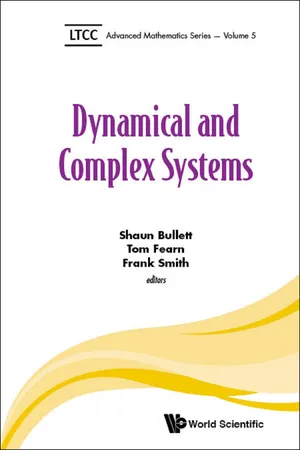
- 228 pages
- English
- ePUB (mobile friendly)
- Available on iOS & Android
Dynamical and Complex Systems
About this book
-->
This book leads readers from a basic foundation to an advanced level understanding of dynamical and complex systems. It is the perfect text for graduate or PhD mathematical-science students looking for support in topics such as applied dynamical systems, Lotka–Volterra dynamical systems, applied dynamical systems theory, dynamical systems in cosmology, aperiodic order, and complex systems dynamics.
Dynamical and Complex Systems is the fifth volume of the LTCC Advanced Mathematics Series. This series is the first to provide advanced introductions to mathematical science topics to advanced students of mathematics. Edited by the three joint heads of the London Taught Course Centre for PhD Students in the Mathematical Sciences (LTCC), each book supports readers in broadening their mathematical knowledge outside of their immediate research disciplines while also covering specialized key areas.
--> -->
Contents:
- Chaos in Statistical Physics (Rainer Klages)
- Aperiodic Order (Uwe Grimm)
- Complex Systems Dynamics (Hannah M Fry)
- Dynamical Systems in Cosmology (Christian G Böhmer and Nyein Chan)
- Lotka–Volterra Dynamical Systems (Stephen Baigent)
- Applied Dynamical Systems (David Arrowsmith)
--> -->
Readership: Researchers, graduate or PhD mathematical-science students who require a reference book that covers advanced techniques used in applied mathematics research.
-->
Frequently asked questions
- Essential is ideal for learners and professionals who enjoy exploring a wide range of subjects. Access the Essential Library with 800,000+ trusted titles and best-sellers across business, personal growth, and the humanities. Includes unlimited reading time and Standard Read Aloud voice.
- Complete: Perfect for advanced learners and researchers needing full, unrestricted access. Unlock 1.4M+ books across hundreds of subjects, including academic and specialized titles. The Complete Plan also includes advanced features like Premium Read Aloud and Research Assistant.
Please note we cannot support devices running on iOS 13 and Android 7 or earlier. Learn more about using the app.
Information
Chapter 1
Chaos in Statistical Physics
1. Introduction
Table of contents
- Cover Page
- Title
- Copyright
- Preface
- Contents
- Chapter 1. Chaos in Statistical Physics
- Chapter 2. Aperiodic Order
- Chapter 3. Complex Systems Dynamics
- Chapter 4. Dynamical Systems in Cosmology
- Chapter 5. Lotka–Volterra Dynamical Systems
- Chapter 6. Applied Dynamical Systems